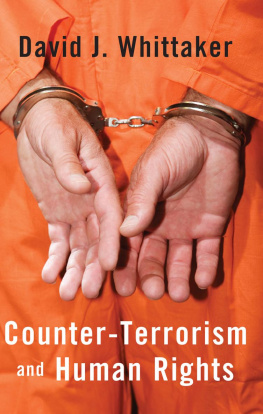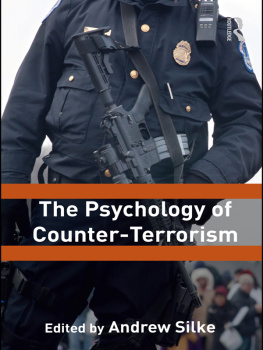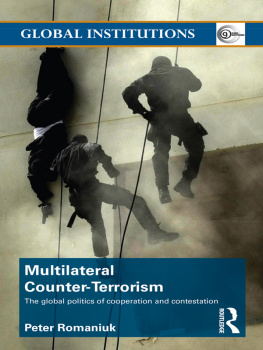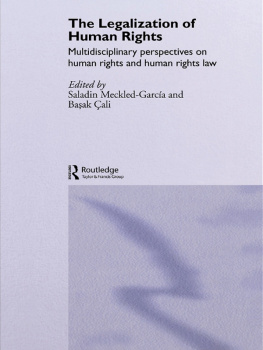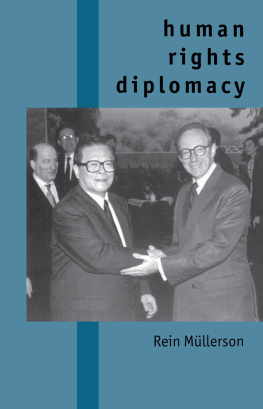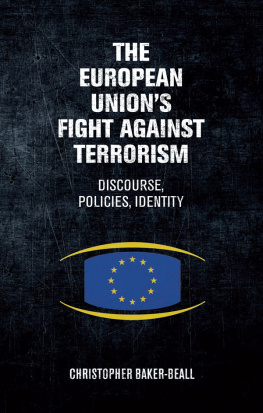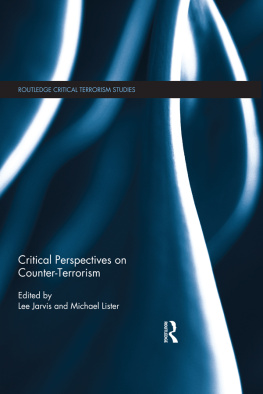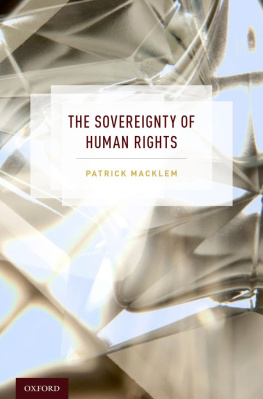Counter-Terrorism and Human Rights
Counter-Terrorism and Human Rights
David J. Whittaker
First published 2009 by Pearson Education Limited
Published 2013
by Routledge
2 Park Square, Milton Park, Abingdon, Oxon OX14 4RN
711 Third Avenue, New York, NY 10017, USA
Routledge is an imprint of the Taylor & Francis Group, an informa business
Copyright 2009, Taylor & Francis.
The right of David J. Whittaker to be identified as author of this work has been asserted by him in accordance with the Copyright, Designs and Patents Act 1988.
All rights reserved. No part of this book may be reprinted or reproduced or utilised in any form or by any electronic, mechanical, or other means, now known or hereafter invented, including photocopying and recording, or in any information storage or retrieval system, without permission in writing from the publishers.
Notices
Knowledge and best practice in this field are constantly changing. As new research and experience broaden our understanding, changes in research methods, professional practices, or medical treatment may become necessary.
Practitioners and researchers must always rely on their own experience and knowledge in evaluating and using any information, methods, compounds, or experiments described herein. In using such information or methods they should be mindful of their own safety and the safety of others, including parties for whom they have a professional responsibility.
To the fullest extent of the law, neither the Publisher nor the authors, contributors, or editors, assume any liability for any injury and/or damage to persons or property as a matter of products liability, negligence or otherwise, or from any use or operation of any methods, products, instructions, or ideas contained in the material herein.
ISBN 13: 978-1-4058-9980-2 (pbk)
British Library Cataloguing in Publication Data
A CIP catalogue record for this book can be obtained from the British Library
Library of Congress Cataloging in Publication Data
Whittaker, David J., 1925
Counter-terrorism and human rights / David J. Whittaker.
p. cm.
Includes bibliographical references and index.
ISBN 978-1-4058-9980-2 (pbk.: alk. paper) 1. Terrorism United States Prevention. 2. Terrorism Great Britain Prevention. 3. Terrorism European Union countries Prevention. 4. Human rights. I. Title.
K5256.W48 2009
363.325'16dc22
2009022551
Set 9/14pt Stone Serif by 35
Contents
I am indebted to a number of people for their time and patience and invaluable advice in the making up of this book:
Mari Shullaw, Christina Wipf-Parry and Jessica Harrison at Pearson Education; Joanna Stephenson at the Royal Commonwealth Society;
Bill Joseph and Adrian Norton for ironing out technical difficulties;
Skeeby Computer Services for typing service;
Marianne Whittaker for painstaking reading of the manuscript in draft and most helpful criticism.
We are grateful to the following for permission to reproduce copyright material:
Extract on page 35 from Whittaker, D., Terrorism: Understanding the Global Threat (Pearson Education, 2006), courtesy of Pearson Education Ltd; extract on page 51 from Letters page, The Guardian , 24/12/2007 (McNulty, Tony), copyright Guardian News & Media Ltd 2007; extract on page 70 from The Guardian (courtesy of Gearty, C).
In some instances we have been unable to trace the owners of copyright material, and we would appreciate any information that would enable us to do so.
Acompanion volume to this book had the title Terrorism: Understanding the Global Threat . It has seemed necessary in a twin volume to go much further and look carefully at what we can do to deal with this threat. Issues to do with counter-terrorism policies are growing ever more significant internationally. Once again, readers can be sure of one thing, namely, that what appears here in print is not all to be understood as the last word. In this case we have a scrutiny of present-day thinking about counter-terrorism and action together with a preliminary discussion of possible lines in the future. Facts and discussion will move from what is to what might or ought to be. Put plainly, the overall purpose is to inform, to speculate a little and, most certainly, to encourage further enquiry and debate. Polemics will be left to the user of the book.
Terror, terrorism and terrorists are words heard every day, everywhere. What they lack, though, whether in print or in spoken usage is agreed, standard meaning. These terms are set in contexts that are generally disputable, vague, and contradictory. Prejudgement, generalisation, even prejudice seem inescapable. Terror has always been a personal reaction in the sense that William Shakespeare used it in Richard III so full of dismal terror was the time! In more modern years terror is commonly viewed as a planned artifice by malevolent individuals or groups. Terrorism demands urgent, collective action to counter it and to restore secure normality. Countering it, though, risks our loss of freedom and elemental human rights. Protection, yes, but at what price?
In the United Kingdom Parliament is continually being asked to approve more and more surveillance procedures which even the retiring Director of Public Prosecution, Sir Ken MacDonald, has considered as powers that would break freedoms back. His relentless prosecutional struggle against terrorism (with conviction rate in excess of 90 per cent) has been conducted, he believes, with restraint and with public and individual rights kept prominently in mind.
Terrorism is wide, deep and unpredictable. This introduction is being written during a week, in October 2008, when some terrorist activity returns both to Northern Ireland and South Africa, where, after longed-for quiet, there has been a reintroduction of gunshots, the raw edge of sectarian infighting. The fragility of reconciliation after terror will certainly underlie facts and hopes in many of the following chapters.
This book will attempt to clarify and disentangle some of the main counter-terrorism problems, such as that of finding a balance between operating strategies and programmes and the importance of conserving human rights. A first chapter presents key issues. Although these issues crop up later, examined in detail, it is considered useful to outline them as headers at the outset. Subsequent chapters range over basic human rights, counter-terrorism in law and practice, the controversies surrounding detention, preliminary charging and court work, punishment and rendition. The approach had to be selective in dealing with issues of the United States, the United Kingdom, Europe and South-east Asia. As far as possible, questions are addressed objectively without attention to conspiracy theories. A section Where to find out more will be found on pages 19092.
In conclusion, something ex-President Clinton said in 2004 at an American Legion dinner is worth repeating. He said of counterterrorism that an important priority would be to dismantle the boxes, in which most of us live, to break down barriers and to mix more freely and tolerantly with others. Terrorism, so he believes, is often the last desperate pitch of the humiliated and the hungry with so many of their rights denied. It is the raw message of those who are neither heard nor understood. Effective counter-terrorism programmes benefit from recruiting not only doers but listeners.

